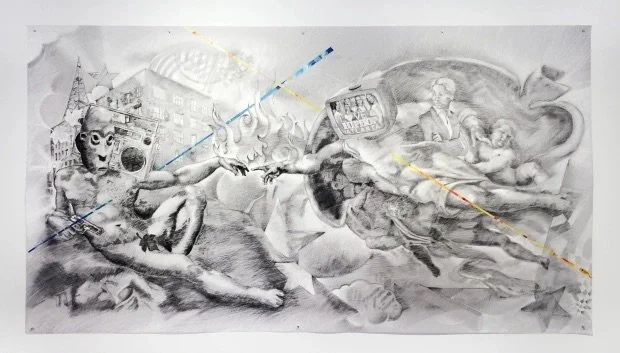Artist Ayo Scott pulls the trigger on some social satire at Octavia gallery
Artist Ayo Scott says that he began his series of post-modern digital drawings, now on display at Octavia art gallery, somewhat casually. In a classic post-modern mode, the 34-year-old artist set out to toy with the meaning of some of western art's best-known images, including Grant Wood's "American Gothic,"Auguste Rodin's "The Thinker,"Leonardo da Vinci's "Mona Lisa" and Michelangelo's ceiling of the Sistine Chapel.
"As it started I was just playing around," he said, "I wanted to juxtapose some European imagery with African masks."
But by the end, Scott's playing around had taken on a cutting edge.
Scott hoped that basing his computer drawings and collages on some of civilization's most universal images could bridge a gap between the art world and people who don't much care about the art world.
"I feel like I'm a liaison, to some degree," he said, "taking art to a different generation or a different demographic. I think there are a lot of people who would appreciate art if it was presented to them in a way that didn't come off as pretentious and what not."
In the center of the Sistine Chapel, Michelangelo depicted God at the moment he animated Adam. In the universally known illustration, their fingers almost touch. Scott began his re-imagining of the scene by placing a carved wooden mask from an African culture over Adam's face. Placing a boom box on Adam's shoulder transformed him into a symbol of 1980-style hip hop, Scott said.
Replacing God's head with television broadcasting the reality series "Love and Hip Hop, Atlanta," symbolized the way, in Scott's view, original, socially significant rap culture has devolved into pop superficiality. The figures behind God look like characters from a painting by the sardonic African-American social critic Robert Colescott. The hot rod flames in the center lend a tongue-in-cheek low-art vibe to the proceedings.
Creation, a digital drawing by artist Ayo Scott
Photo courtesy Octavia art gallery
Those thin colorful stripes that zip through the otherwise black and white drawing are flying bullets, meant to remind us of the seemingly endless gunplay that plagues New Orleans.
"It's my way of dealing with the violence of the city without beating you over the head with the violence of the city," Scott said. "So I wanted them to be kind of suggestive not really literal."
In other ways, though, his indictment of gun violence is less subtle. Adam, who looks somewhat like a shooting victim, clutches a 45-caliber pistol.
In Scott's vision, Michelangelo's awakening of man has become a spark of social consciousness.
The Lies We Believe
Possible ratings: Wow(reserved for drop-dead art experiences such as the 2011 "Music Box/Dithyrambalina" collaborative musical sculpture environment in the Bywater or "Project Be,"Brandan Odums' 2014 series of graffiti portraits of civil rights activists in the unoccupied Florida Housing development),Worthy(rewarding artwork you'll discuss on the drive home) and Whatever(viewing not required)
Rating: Worthy.
What: Artist Ayo Scott strikes out with a socially critical suite of digital drawings and collages.
Where: Octavia art gallery, 454 Julia St.
When: The exhibit continues through Sept 6. Gallery hours are Tuesdays-Sundays, 10 a.m. to 6 p.m.
More information: Visit the Octavia gallery website or call 504.309.4249.
Those colorful bullet stripes slice unexpectedly through all of Scott's post-modern pastiches as if, in New Orleans anyway, the unifying factor is danger. To Crescent City art lovers they may symbolize something in addition to violence. The same sort of colorful rays appeared regularly in Ayo's father John T. Scott's paintings and sculpture.
The elder Scott, who died in 2007, was a longtime Xavier University professor, winner of a MacArthur Genius Award and one of New Orleans' most renowned modernists. It's difficult to look at Ayo's art without searching for dad's influence.
Ayo, who works as a graphic designer as well as a fine artist, views his dad as a great role model.
"He was just an amazing artist," Ayo said. "I'm sure I'm biased in saying so, but he was the greatest artist I met, an incredible teacher, just a very giving person. He was always trying to get people to question what they knew of something and offer new information that was one of the things he was into."
Ayo resists using his father's lush colors because, he said, they'll just take over his art. It's not surprising. As a child, he said, even the hand-made toys his father made for him were coated with layers of bright paint.
John Scott's work was sometimes topical, but his work was most often abstract. Ayo's art – at least the work on display at Octavia gallery through Sept. 6 – is much more explicitly political. Those color stripes are the clearest link between the two artists.
In Ayo Scott's retelling of "American Gothic," the scene takes place in the post-Katrina ruin of the flooded Lower Ninth Ward. Scott's version of "Mona Lisa" is smoking cigarettes and waiting for a cell phone call down by the river. In his satire of "The Thinker," he poses the seated nude atop a commode, contemplating social and racial inequities. A world map spreads out at the statue's feet. America seems to have disappeared down the drain. A colorful random bullet ricochets off of a hovering heart.
